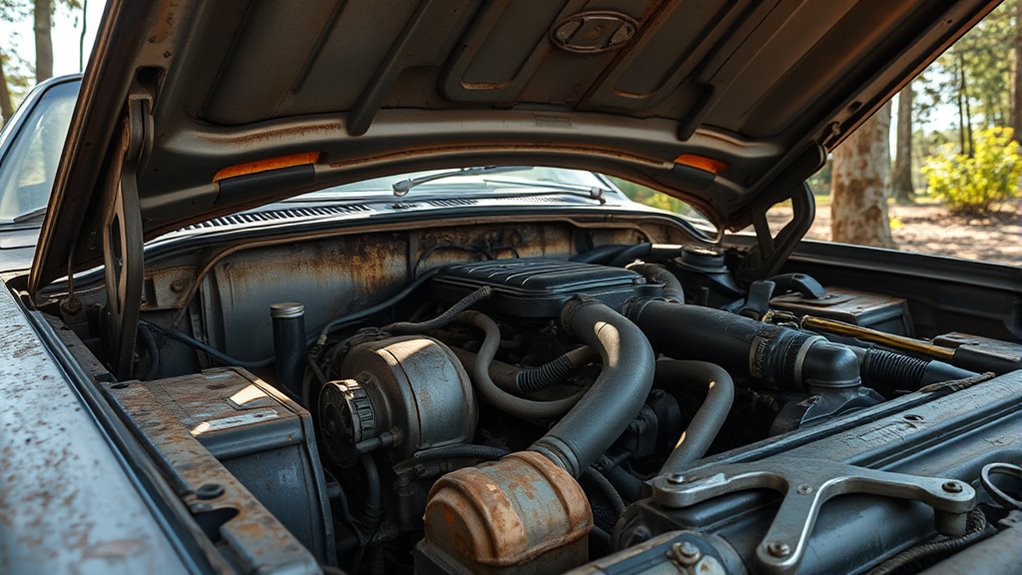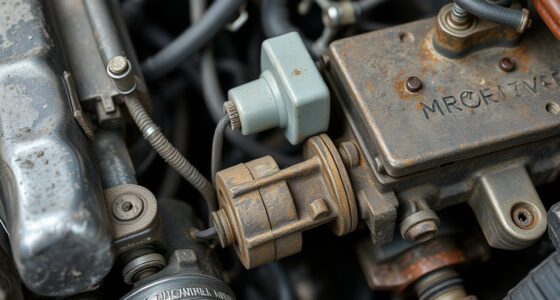Owning a car costs more than its purchase price, mainly due to ongoing maintenance and repairs. Regular upkeep like oil changes, tire rotations, and brake checks prevent costly breakdowns, while ignoring these can lead to bigger expenses. Fuel efficiency and insurance premiums also add to your costs. Planning for unexpected repairs by setting aside some funds can keep surprises manageable. Keep exploring to understand how smart maintenance choices can save you money long-term.
Key Takeaways
- Ongoing maintenance and repairs significantly add to the total cost of car ownership beyond the initial purchase price.
- Regular upkeep, like oil changes and tire rotations, prevents costly future repairs and extends vehicle lifespan.
- Unpredictable repair expenses require budgeting for emergency funds to avoid financial strain.
- Vehicle choice impacts repair frequency and costs, with some models being more prone to certain issues.
- Proper maintenance improves fuel efficiency, reducing ongoing fuel expenses and overall ownership costs.

Owning a car often seems like a straightforward way to get around, but the true cost goes far beyond the initial purchase price. As you begin to factor in ongoing expenses, maintenance and repairs quickly become significant. These costs can be unpredictable, so it’s essential to understand what you’re up against. One of the key elements influencing your ongoing costs is fuel efficiency. A vehicle with higher fuel efficiency helps you save money at the pump, reducing your overall expenses. Conversely, less efficient cars might seem cheaper upfront but can drain your wallet over time through increased fuel costs. Regularly monitoring your car’s fuel efficiency and maintaining proper tire pressure can improve mileage, gradually offsetting some of those expenses.
Insurance premiums also play a vital role in the total cost of ownership. Car insurance is mandatory, and premiums can vary widely depending on your vehicle type, driving history, and location. Newer or high-performance cars often come with higher premiums, adding a considerable chunk to your monthly budget. If you’re not careful, these costs can sneak up on you, especially if you’re involved in an accident or receive traffic violations. Shopping around for the best insurance rates and bundling policies can help you save money. Additionally, some cars are cheaper to insure because they’re less likely to be stolen or involved in accidents, so choosing a vehicle with lower insurance premiums can be a smart move to keep your costs manageable.
When it comes to maintenance and repairs, you shouldn’t wait until something breaks down to start budgeting. Regular maintenance—like oil changes, brake inspections, and tire rotations—keeps your car running smoothly and can prevent costly repairs down the line. Neglecting these routine tasks might save you some money upfront, but it often results in bigger expenses later. Repairs, especially unexpected ones, can be a financial strain, so setting aside funds for emergencies is wise. Some issues are more common in certain makes and models, so researching your vehicle’s reliability before buying can save you from surprise repair costs. Moreover, the use of professional voice actors in advertising can help communicate the importance of regular maintenance and responsible ownership, making the message more compelling. Additionally, choosing a reputable mechanic and sticking to recommended service intervals ensures your car remains in good shape, ultimately reducing the need for expensive repairs.
Frequently Asked Questions
How Often Should I Perform Preventive Maintenance on My Vehicle?
Think of your car as a trusted sidekick needing regular check-ins. You should perform preventive maintenance like tire rotation and oil change every 5,000 to 7,500 miles or as recommended in your owner’s manual. Regular oil changes keep the engine running smoothly, while tire rotations ensure even wear. Staying consistent with these simple tasks prevents costly repairs down the line and keeps your vehicle in top condition for the road ahead.
Are There Cost-Effective Ways to Reduce Repair Expenses?
You can save money by doing DIY repairs when possible, which reduces labor costs. Keep up with regular maintenance to prevent costly issues later. Also, check if your insurance offers discounts for safe driving or vehicle upgrades; these can lower overall expenses. Staying proactive and informed about your car’s needs helps you cut repair costs effectively, making car ownership more affordable in the long run.
What Signs Indicate My Car Needs Urgent Repairs?
Imagine your car as a patient showing warning indicators; strange noises, warning lights, or a sudden pull can signal urgent repairs. If your brakes squeal, the engine stalls, or there’s a fluid leak, don’t delay. These signs point to underlying issues needing immediate attention. Ignoring them risks costly damage or breakdowns. Always listen to your car’s signals and seek professional help when you notice these urgent repair warning indicators.
How Does Driving Style Affect Maintenance Costs?
Your driving habits directly impact maintenance costs. Aggressive driving, like rapid acceleration and hard braking, increases wear and tear on your vehicle, leading to more frequent repairs. Smooth, steady driving helps improve fuel efficiency and reduces strain on engine components. By adopting better driving habits, you can lower repair expenses and extend your car’s lifespan, saving you money over time.
Can Extended Warranties Save Money on Repairs?
Extended warranties can save you money on repairs by providing added repair coverage, especially for costly issues beyond the manufacturer’s warranty. If you tend to keep your car longer or worry about unexpected repair bills, investing in an extended warranty might be a smart choice. It helps you avoid large out-of-pocket expenses, giving you peace of mind. Just read the coverage details carefully to make certain it fits your needs and budget.
Conclusion
Remember, while maintenance and repairs can seem costly, they’re essential for keeping your car running smoothly and saving you money in the long run. Don’t let the expense discourage you; regular upkeep prevents bigger, pricier issues down the road. By staying proactive, you’ll enjoy a safer, more reliable ride and potentially boost your car’s resale value. Embrace the maintenance routine—it’s an investment in your vehicle’s longevity and your peace of mind.









